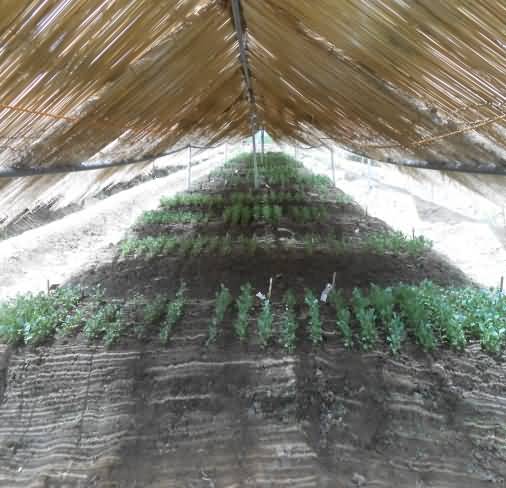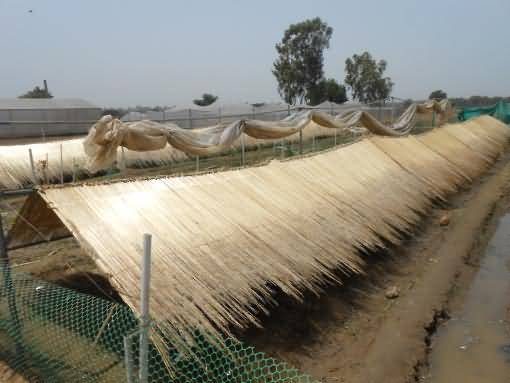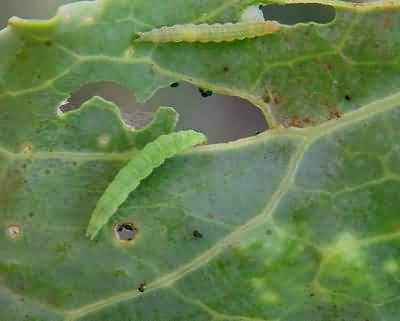उच्च पोषण और आय के लिए फूलगोभी उगाऐं
Cauliflower is one of the most important winter vegetable grown by the farmers of our country. The edible part is the vegetative portion of the plants known as curd.
It is rich in vitamins, minerals, fiber and bioactive compounds such as anthocyanins, beta-carotene, glucosinolate. Besides these, it is also high in folate, potassium and calcium.
It is considered as cancer (colon cancer, bladder cancer, breast cancer) fighting super vegetables due to high vitamin C, potassium, soluble fiber, folate, carotenoids and glucosinolates.
It also helps in reducing serum cholesterol and also curing progeria disease, osteoarthritis. The mean glucosinolate content of is given in Table 1.
Table 1: Mean Glucosinolate Content (umol g-1 Dry Mass) in the edible tissues of cauliflower
| Glucosinolates | Cauliflower | |
| Group | Form | |
| Aliphatics | Sinigrin | 9.3±0.1 |
| Gluconapin | 0.3±0.2 | |
| Glucobrassicanapin | 0.1±0.0 | |
| Progoitrin | 0.3±0.1 | |
| Epiprogoitrin | 0.0±0.0 | |
| Napoleiferin | 0.2±0.1 | |
| Glucoiberin | 0.0±0.0 | |
| Glucoraphanin | 0.5±0.3 | |
| Glucoalysin | 0.0±0.0 | |
| Phenyl indoles | Gluconasturtiin | 0.4±0.0 |
| Glucobrassicin | 1.3±0.1 | |
| 4-OH glucobrassicin | 1.6±0.0 | |
| 4CH3OH glucobrassicin | 0.2±0.00 | |
| Total | 15.1 | |
Climate and soil for Cauliflower
Cauliflower is thermo-sensitive crop and requires cool moist climate. The early varieties may tolerate higher temperature and long days. The temperature requirement depends on the maturity group.
It may transform curding from 5oC to nearly 28-30oC. The optimum temperature for young seedling is 23oC. Growth is also poorer at mean minimums of less than 7°C. Mature curds, if not protected by leaves, can be easily damaged by only a few degrees of frost.
Heavy frosts can cause serious damage to the crop, particularly with sudden cold snaps. The optimum temperature range for curd initiation and development of different maturity groups of cauliflower is given in table 2.
Deep loamy soils with a pH range of 5.5 to 6.6 with higher organic matter content and good drainage are suited for cauliflower cultivation.
Table 2: The average temperature for curd initiation in different groups of cauliflower
| Cauliflower maturity groups | Avg. Temp for curd formation |
| Early I | 20oC to 27oC |
| Early II | 20oC to 25oC |
| Mid early | 16oC to 20oC |
| Mid-late | 12oC to 16oC |
| Late | 10oC to 16oC |
Growing season and varieties of Cauliflower:
Cauliflower can be grown throughout the year. The important varieties and their growing period is given in Table 3.
Table 3: Growing period and varieties of different groups of cauliflower
| Cauliflower | Cultivars | Time of sowing | Availability period |
| Early I | Pusa Meghna, P. Kartik Sankar, Pusa Ashwini | End of May/Ealry June | Aug. end-early Oct. |
| Early II | Pusa Kartiki | Mid June | Oct. - Nov. |
| Mid early | Pusa Hybrid-2, Pusa Sharad | July-Aug. | Nov. to Dec. |
| Mid-late | Pusa Paushja, Pusa Shukti | End of Aug. | Dec. – Jan. |
| Late | Pusa Snowball K-1Pusa Snowball Kt-25 | Sept. – Oct. | Jan. – Mar. |
Seed sowing and nursery management of Cauliflower:
For an area of 100 m2, a nursery area of 3 m x 1 m is sufficient. The soil should be solarized or Trichoderma viride should be mixed in cow dung manure@ 100 g per 5 kg before sowing of seed. The seeds are treated with captan or thirum @ 2 g/kg seeds.
For early cauliflower nursery bed should be prepared in shade and seedling should be protected from high temperature by making Sarkanda roof. Seedlings of mid early crops should be protected from high rainfall by providing polythene cover and proper drainage facility.
The seedlings are ready for transplanting in 40-45 days after sowing for early crops and 30 days after sowing for late crops. For early crop, 550 g seeds are required to plant one hectare area while 400 g are sufficient for mid and late crops.
The seedlings are planted at a specing of 45 x 45 cm for early crop and 60 x 45 cm for late crop.
Manuring and fertilization in Cauliflower production
Cauliflower responds well to manuring, as they are heavy feeder. A fertilizer dose of 120 kg N, 80 kg P2O5, 40 kg K2O, should be applied for one hectare area. Excess of N may cause abundant leafy growth and a delayed crop maturity.
Split application of N is more beneficial. Half of N along with full quantity of P and K are applied at the time of transplanting. The remaining half N is applied in 2 equal splitdoses, 3 weeks after transplanting and the other at the curd/head/knob development stage. The farmyard manure @ 25 tones/ha is added to soil 4–6 weeks before transplanting.
The deficiency of B, Mo and N may induce physiological disorders such as browning, whiptail and buttoning. Foliar application of urea (1–2%) to correct the N deficiency is useful andeconomical.
Multiplex (0.2–0.3%) can be sprayed to correct the general micronutrient deficiencies. However, to correct deficiency alone, 150 g borax and 0.5 % ammonium molybdate are beneficial.
After care of Cauliflower crop
The intercultural operations are performed mainly to check the weed growth to make the soil loose and to maintain proper moisture condition. Since its root system is shallow, hoeing is done to keep the crop weed-free.
Presence of weeds in the early stages reduces the yield due to poor growth of the plants. Timely hoeings help to check the weed population. As soon as the weeds start appearing, shallow hoeing followed by earthing up should be done.
Irrigation in Cauliflower crop
Cole crops require a continuous supply of moisture for uniform growth and development. First irrigation is done immediately after transplanting and thereafter irrigation is done when needed, depending on soil and weather conditions.
The curd/ head/ knob initiation is the critical stage of irrigation. Irrigation at 15 days interval are adequate in ridge and furrow method. Heavy irrigation should be avoided.
Tieing of cauliflower leaves or blanching
Cauliflower curds are exposed to the sun and they tend to discolour and lose the desired whiteness. Some cultivars have good wrapper leaves around the curd and are naturally well protected or self blanched type.
Blanching is an essential operation to protect the curd from sunlight and yellowing, so that they may not attractive appearances. It is done by drawing and trying of the upper leaves. If is not possible, a cauliflower leaf is placed over the curd to protect it from the sun.
This help in retaining milky white colour to the curd. Blanching should be done only when the curd is grown fully, and leaves should not be left tied over for more than 4- 5 days. But these periods may be increased to one week in cold weather and reduces to 2 – 3 days during the hot weather.
Harvesting and yield of Cauliflower
Cauliflower is harvested when the curd has developed the proper size and compact. In case of early crop give 500-600 g curd while in case of late crop give 1000-1200 g curd.
Problems in Cauliflower production
1. Buttoning
The buttoning means formation of small button like curds. The reasons are attributed to planting of over aged seedlings, poor nitrogen supply, planting early varieties in late season and change in temperature. This problem can be solved by planting crop according to their planting time.
2. Riceyness
It is the premature initiation of floral bud due to peduncle upright. Riceyness results due to unfavorable temperature for a given variety.
3. Browning and hollow stem
This is caused due to deficiency of boron in soil. The water soaked area developed on the curd which later turns brown. This browning as associated with hollow stem. This can be controlled by applying borax 200 g for 100 m2 area or spraying of boron 0.25 to 0.50 % solution.
4. Whiptail:
Young plants turn white particularly along the leaf margins and only mid rib present. Apply ammonium molybdate @ 10 g for 100 m2 area.
5. Blindness
Blind cauliflower plants are those without terminal buds. The leaves which develop are large, thick leather and dark green. Blindness is supposed to be due temperature or injury due to cultural operation, insect and pest disease.
6. Pinking
Pinking of the curd occurs due to deposition of anthocyanin in high intensity of light.
7. Cracking of knobs
In knolkhol the knobs cracks due to boron deficiency or heavy irrigation after dry spell.
Insect pest
1. Diamond-back moth (Plutella xylostella)
The larvae feed on the under-surface of the leaves without damaging the epidermis of the upper surface, thus leaving so-called "windows" in the leaf, which are diagnostic characteristics for these pests.
2. Cabbage Butterfly (Pieris brassicae)
The bluish green with black spot in larvae feed leaved starting from margin to the centre.
Control
- Removal of caterpillar is the best method for the control of larvae.
- Spraying of neem oil @10000 ppm
- Spraying Bt formulation Delfin 3G @1 g/liter
- Cypermethrin @ 0.5 ml/Litre
Diseases
1. Damping off
It is a common problem in the nursery bed. The affected plants fall down and die due to shrinking of cortical tissue of hypocotyls.
Control Measures:
- Proper drainage in the nursery
- Soil solarization or drenching the nursery bed with formaldehyde or brassicol about 3 -4 weeks prior to sowing,
- Seed treatment with mercurial fungicide @ 2 gm per kg of seed
- Avoiding thick sowing and spraying the seedlings with Dithane M – 45 or Dithane Z- 78 @ 2.5 gm per liter of water are the common remedial measures.
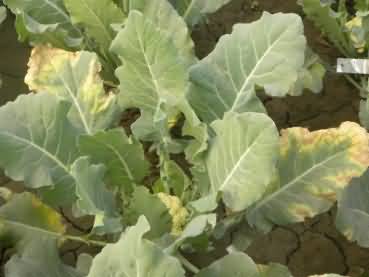 2. Black rot (Xanthomonas campestris pv. campestris)
2. Black rot (Xanthomonas campestris pv. campestris)
This is a bacterial disease. In the affected plants the margin of leaves show V shaped yellow spot and vein becomes dark and vascular discoloration takes place in the main stem.
Control Measures:
- Growing resistant varieties like Pusa Mukta in cabbage, Pusa Subhra and Pusa Snowball K1.
- Hot water treatment of seeds at 50o C for 15 minutes
- 0.01 % streptocyclin spray
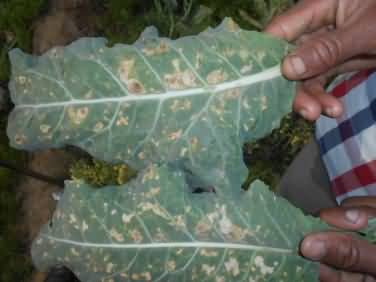 3. Downey mildew (Hyaloperospora parasitica)
3. Downey mildew (Hyaloperospora parasitica)
The first observable symptom is small, light green-yellow lesions on the upper leaf surface, later showing on the undersurface.
Control measures:
- Growing resistant varieties such as Pusa Hybrid 2, Pusa Snowball K1.
- Application of Ridomil @2 g/Litre
Economics of cultivation of cauliflower
The production cost of cauliflower is similar as compared to other traditional vegetables. The farmers can earn more from early cauliflower. The detail of economic return of cole crop cultivation is given in table 4.
Table 4: Economics of exotic vegetables cultivation
| Crop | Yield (t/ha) | Cost of cultivation (Rs) | Lowest selling price (Rs/kg) | Net income (Rs) |
| Early | 15 | 50500 | 30 | 399500 |
| Late | 30 | 45500 | 5 | 104500 |
Authors:
Partha Saha
Division of Vegetable Science
IARI, Pusa, New Delhi 110012, India
E-mail:

